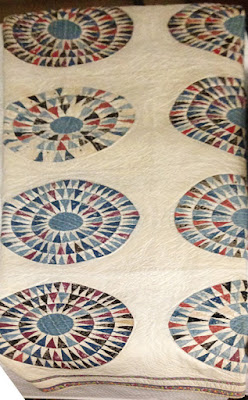I'm not going to be piecing this triple sunburst any time soon but it's interesting how
many stitchers took on the challenge in the past.
Northeast Auctions offered this wonder in pink, points and applique a few years ago.
1856
Source?
Elaborate appliqued borders would indicate mid-19th-century style.
Nancy Cummins Kaylor from Jefferson County, Indiana.
Indiana Project & the Quilt Index.
Collection of the Iowa State Historical Society
Another said to have been made in Indiana by
Mrs. R.L. Whittington, Iowa Project.
These last two, a little more austere in the applique, are both thought
to date from the last quarter of the 19th century.
The pattern has a BlockBase number #3469 although it was not published until the 1970s.
You can see the center as a sunburst with two rings around it.
Wyoming Project
Several examples from 1890-1930 survive. These are certainly graphic.
Joanna Rose's collection
Turn- of-the-last-century examples usually have nine blocks.
Source?
Some kind of communication going on about how these are supposed to look.
Unusual in its use of prints.
The caption for has read that it was stitched by Eliza McCardle Johnson (1810-1876), wife of President Andrew Johnson, but since she died years before the blues were fashionable that whole story is highly suspect.
See another dubious link to Eliza Johnson and quilts here:
The Arizona Project recorded a pair in the same prints attributed to Rhoda
Marshall & Thelma Lines, perhaps made in Colorado or Arizona.
Roberta Horton found this one with half blocks along the side in Oklahoma.
Source?
You can find sunbursts with more than 3 rings...
Source?
And fewer than 3 rings,
but the version with three rings seems to have been some kind of pattern fad.
Julie Silber's Inventory
Red and '30s green with an ice-cream cone border, clues to
a post 1930 date.
Here's a BlockBase pattern based on a central sunburst with 14 spokes. Print it out as is for a 15" finished block.
A relative---star in the center instead of sunburst---documented in the Arizona project, made in Kentucky in 1937. Arrie Ethel Boggs Wheeler (1889-1942) "offered to piece the circles with tiny triangles if [Emma Wheeler] would provide material. Emma then put it together." Emma's daughter recalled it as made in 1937. So Arrie specialized in the spiky points. See a post about this cooperative quilt here:





















These are so beautiful. Thank you for researching and sharing them.
ReplyDeleteThese are just amazing!
ReplyDeleteAnd just imagine the number of those blocks that got tossed because they would not lie flat.
ReplyDelete